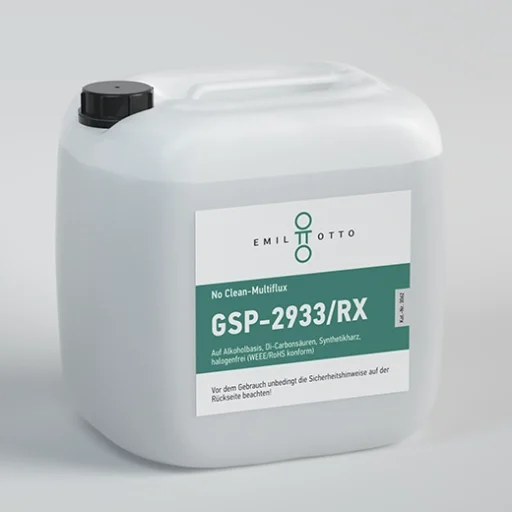No Clean-Flux, alcohol-based
Di-carboxylic acid complex, halogenide-free (WEEE/RoHS compliant)
Type ISO 9454: 1231 (1.2.3.A) // DIN-EN 61190-1-1 (J-STD-004): (IEC REL0)

| Appearance/smell: | colourless to reddish, clear liquid |
| Hazardous goods: | Yes |
| Solids content: | 2.9 wt.-% |
| Acid number: | 25 – 29 mg KOH/g |
| Halogenide-free: | Yes |
| Resinous: | Yes |
| Available as concentrate: | No |
| Density at 20 °C: | 0.79 (+/-0.005) g/ml |
| Flash point: | 12 °C |
| Durability: | 12 months |
GSP-2933/RX is a flux of the latest generation. It is a high performance No Clean-Flux based on alcohol with di-carboxylic acid activator complex and synthetic resin. This flux was used for selective and wave soldering process, as well as for dip soldering process and cable strands tining. The application can be carried out by any usual application method (inclusive foams). This flux is very versatile, both in wave soldering and special applications are good results. The generally valid rule to choose applied flux quantities as low as possible, also applies to this product.
Spray fluxing: When dosing, the amount of flux initially to 15 – 30 ml/min. adjust the uniform flux distribution on the printed circuit board (if necessary test with thermal paper) and then correct to the optimum amount.
Foam fluxing (foam flux application): The compressor output should be even, so that a stable and fine-pored foam crown is achieved. When compressed air supply from the network, the interposition of a water and oil separators and at least one pressure reducer is required. Optimal is an air pressure in the range of 0.6 – 0.8 bar. Fine-pored foam stones or pipes (10 – 20 μm) facilitate foam flow. The nozzle slot should not be more than 15 mm. Side-mounted, perforated support plates promote the stability of the foam. After the foam has been flown, it is recommended to blow off with air to evenly distribute the flux and retain excess amounts.
Density correction: The Flux Thinner “K-113”, Cat.-No. 1003, is available for this purpose.
Preheating: For “simple” PCBs, a preheat temperature of 80 – 110 °C, recommended for “more complex” boards from 100 – 130 °C on the top side of the PCB. The use can be made both in leaded and lead-free solder systems.